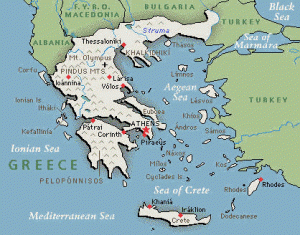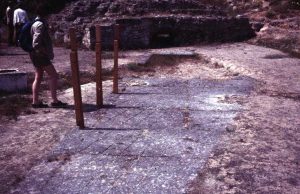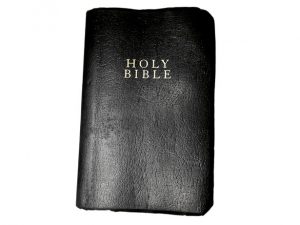Last week, we examined the deities worshiped in ancient Corinth and saw how influential goddesses, as well as gods, were before, during and after the time of St. Paul. Here we will look at the status and role of women at Corinth, especially how their involvement in society and local cults may have influenced Paul and the development of the early church.
Women in Corinthian Society and Ancient Goddess Cults
 As we noted last time, women played significant roles in cults to pagan deities in Corinth and its surrounding region in antiquity. This means that, in the centuries leading up to the advent of Christianity, women were routinely involved in the area’s religious practices – not just in the privacy of their homes but in public rituals, festivals, processions and other events.
As we noted last time, women played significant roles in cults to pagan deities in Corinth and its surrounding region in antiquity. This means that, in the centuries leading up to the advent of Christianity, women were routinely involved in the area’s religious practices – not just in the privacy of their homes but in public rituals, festivals, processions and other events.
As we saw, women were highly involved in the cult of Aphrodite – and there were several temples to Aphrodite in and around Corinth. By the late second century CE – after the time of Paul – Aphrodite was viewed as “guardian of the city” by women. (It is not unusual for a goddess to be acknowledged as a city protector: Roma at Rome, Artemis at Ephesus and Athena at Athens are some examples. A goddess, therefore, was viewed as powerful against natural and human enemies and served the entire community, not just women.)
The large volume of statues, terracotta lamps and figurines to Aphrodite found by archaeologists is evidence for extensive cultic involvement by people with limited resources, especially women. Women may have created these artifacts on their own or purchased them by craftspeople.
Similarly, the archaeological evidence also shows vibrant and long-term involvement of women in the cult of Demeter and Kore (Persephone), as we noted. Artifacts discovered include curse tablets, votive offerings, lamps, fragments of priestess heads, and miscellaneous objects concerned with agrarian fertility, the sphere of the female. Meals, especially those featuring grain, fruit and nuts, were prominent in the cult, and the evidence shows that women took these cultic meals in the typical reclining fashion, just like men. As in the case of Aphrodite, the Demeter and Kore cult would have been active in Corinth at (and possibly after) the time of Paul. 
Evidence from various cults in antiquity shows that roles that leaders would have played included managing and scheduling festivals and processions, maintaining the temples, handling funds, caring for cult statues and offerings, dealing with members and city officials, handling food and drink, and burying deceased members. Both men and women would have fulfilled these roles, depending on the cult. It is also important to note that cults involved with fertility should not be seen by moderns as “merely” important to women; rather, if animals, plants and human beings were not fertile or reproducing, it would be disastrous for the entire community, so fertility – in effect, life in all its forms – was crucial to everyone.
 Epigraphic (inscription) evidence indicates another example of women at Corinth – as accomplished athletes! An inscription from the Greek site of Delphi attests to the participation of several female athletes in the Isthmian and other games (Isthmia was located on the Isthmus of Corinth). Hedea was the winner of the Isthmian race for war-chariots in 43 CE and of the 200 meters at the Nemean games in honor of Zeus; she also “carried away the prize for young lyre-players at the Sebastea in Athens.” (Murphy-O’Connor, Corinth, 16) A woman named Dionysia was winner of the 200 meters at the Isthmian games and the Asklepian games in Epidauros, and a Tryphosa was a winner of the 200 meters at both the Pythian games in honor of Apollos and the Isthmian games [photo left].
Epigraphic (inscription) evidence indicates another example of women at Corinth – as accomplished athletes! An inscription from the Greek site of Delphi attests to the participation of several female athletes in the Isthmian and other games (Isthmia was located on the Isthmus of Corinth). Hedea was the winner of the Isthmian race for war-chariots in 43 CE and of the 200 meters at the Nemean games in honor of Zeus; she also “carried away the prize for young lyre-players at the Sebastea in Athens.” (Murphy-O’Connor, Corinth, 16) A woman named Dionysia was winner of the 200 meters at the Isthmian games and the Asklepian games in Epidauros, and a Tryphosa was a winner of the 200 meters at both the Pythian games in honor of Apollos and the Isthmian games [photo left].
Named Women and St. Paul at Corinth
By the time Paul and the Christ cult arrived at Corinth, women were already an integral part of the fabric of religious and social activity in the community. (It is also very important to note that these early believers were Jews; Judaism and Christianity did not separate until at least 73 CE.) It is logical to infer, therefore, that women at Corinth would not have been especially attracted to the cult to Jesus the Christ if they were shut out of its rites and rituals. While some women may have been attracted to a deity like Jesus and his message of love and compassion, it is unlikely that they would have become enthusiastic converts if the cult and its beliefs did not meet their personal, everyday, family or communal needs. We must keep this in mind when we analyze New Testament passages below that put women in a negative light.
We will start, however, on the positive side: we know that Paul worked closely with three women named in his authentic letters. We will discuss each of them in turn.
The most notable is a missionary and church leader named Priscilla (the name is a diminutive of the Roman name Prisca). In I Cor. 16:19, Paul mentions Prisca and her husband Aquila: “The churches of Asia send greetings. Aquila and Prisca, together with the church in their house, greet you warmly in the Lord.” Prisca and Aquila are also referred to in II Timothy 4:19 (an epistle written after Paul’s death): “Greet Prisca and Aquila, and the household of Onesiphorus.” Finally, the pair is mentioned in Acts of the Apostles 18:26: “[A Jew named Apollos] began to speak boldly in the synagogue; but when Priscilla and Aquila heard him, they took him aside and explained the Way of God to him more accurately.” Acts was written about 100 CE and is not necessarily accurate historically.
As Jouette Bassler notes, Prisca and Aquila’s trade was tent-making, like Paul’s. The pair had moved to Ephesus from Corinth with Paul. They stayed in Ephesus after Paul moved on, “overseeing the church that met in their house.” It appears that they returned to Rome after an edict against Jews was lifted in 54 CE, where they established yet another house church, in which Prisca was most likely more involved than her husband. They seem to have provided support for Paul and his mission in several cities in the form of patronage, teaching and preaching, and they may have been converts to the Christ cult even before meeting Paul. The passage in Acts suggests that, even if they did not literally teach the gospel to Apollos, their influence was significant, since the memory of their ministry was still alive in the early second century. Another indication of Priscilla’s lasting influence is the suggestion that she was the author of the letter to the Hebrews in the New (Christian) Testament, but this cannot be firmly established.
The second woman associated with Paul and Corinth is Chloe, mentioned in I Cor. 1:11-12: “For it has been reported to me by Chloe’s people that there are quarrels among you, my brothers and sisters. What I mean is that each of you says, ‘I belong to Paul,’ or ‘I belong to Apollos,’ or ‘I belong to Cephas,’ or ‘I belong to Christ.’” (The men named Apollos, whom we encountered above, and Cephas were two other leaders at Corinth.) 
Perhaps not surprisingly, given the general absence of a discussion of women in the history of scholarship, New Testament commentaries have paid little attention to Chloe and made little of her possible significance to the Corinthian community. The mention of her “household,” however, suggests status. She was likely head of her household, and thus possibly a widow, and as such at least moderately well-to-do if not wealthy. She had the means and desire to sponsor emissaries to Paul, although “her people” could also have seen Paul while on other business. If Chloe was the head of a household in Corinth, it is possible if not likely that she owned slaves and/or had persons dependent upon her and was well known in Corinth. Chloe was thus a woman whom Paul held in high esteem for her leadership abilities and faithfulness.
Finally, Paul was also associated with a deacon named Phoebe, the church leader at Cenchreae, one of Corinth’s harbors; the reference to Phoebe is in Paul’s letter to the Romans (16:1-2): “I commend to you our sister Phoebe, a deacon of the church at Cenchreae, so that you may welcome her in the Lord as is fitting for the saints, and help her in whatever she may require from you, for she has been a benefactor [“prostatis”] of many and of myself as well.” Phoebe’s roles are highly significant, given the traditional view of male Biblical commentators and the Roman Catholic Church. As we noted in an earlier post, Phoebe’s responsibilities as a deacon would have been the same as that of male deacons. A “diakonos” had specific roles in the early church as a leader and official; female deacons did not merely minister to women or the sick, as earlier analysts had argued. The Roman Catholic Church still does not ordain women deacons, despite the role of Phoebe in Paul’s time.
As a benefactor or patron, Phoebe would also have had great influence on the early church in the Corinthian region. Quoting Bassler, “As a patron she would . . . have provided funds for the church and probably publicly represented it when necessary. She would also have used her influence – derived from her wealth and social standing – to resolve any difficulties that might arise for the congregation. . . She is obviously an independent woman . . . of considerable means.”
Anti-Woman Passages in I Corinthians
Contrary to this powerful evidence for Paul’s involvement with and respect for women, two specific passages in I Corinthians point in the opposite direction and are often cited by religious conservatives to bolster anti-women sentiments in the Bible . What’s going on?!
In I Cor. 11:2-16, Paul argues that women should wear a veil while praying in church. This is also a passage that states that “the husband is the head of his wife,” and “he is the image and reflection of God; but woman is the reflection of man.” For those on the Christian right who view Paul as a definitive authority and tend to ignore the active roles of his named female colleagues, this passage serves to support the view that women should be subordinate to men, both in the church and in the home.
As author Margaret Mitchell points out, however, Paul tempers these patriarchal notions with an opposite statement in verse 10: “For this reason a woman ought to have a symbol of authority on her head, because of the angels.” Commentators since antiquity have attempted to explain this extreme turn in Paul’s thinking in various ways, none of which are entirely satisfactory. Mitchell concludes that Paul is revealing his uncomfortable position at Corinth, since women have apparently been publicly preaching and prophesying in the assembly already, and that has caused division. He is walking a thin line as he tries to mediate the situation. On the one hand, he is echoing the traditional view of male supremacy, while on the other he acknowledges women’s active roles in the church.
The second passage often used by the Christian right to “keep women in their place” is I Cor. 14:33B-35; here, Paul states that women should keep silence in the church, should not speak, and should ask their husbands at home if they want to know something. This seems suspicious given all the women around Paul who were obviously exercising some authority in the congregations. As Mitchell notes, for a number of reasons, “[m]any contemporary New Testament scholars, both women and men, regard part or all of these verses to be a later editorial insertion into Paul’s letter, likely by a subsequent follower of Paul, such as the one who penned the pseudepigraphical letter I Timothy.” While other scholars (of a more conservative bent or feminists who dislike Paul) argue for the authenticity of these verses, I am inclined to believe the interpolation argument (since such interpolations were not infrequent occurrences in textual transmission of Biblical texts). The overall evidence of Paul’s view of women – not only in the Corinthian correspondence but elsewhere too in his authentic letters – argues for his respect for women, not his desire to suppress their participation in the congregations.
Conclusion
While traditional treatments of Corinth and the Pauline Corinthian correspondence focus heavily on men and male deities – Apollo, Poseidon, Zeus, St. Paul, Apollos, Cephas, and Aquila – it should be apparent from the evidence presented here that female deities and female worshipers played significant roles in the life of this community throughout its existence. Goddess cults such as those of Aphrodite, Artemis, Demeter and Kore were not only popular prior to the Hellenistic era, they were also reborn in the Graeco-Roman period, existed alongside nascent Christianity, and even survived into the early Byzantine era. The evidence demonstrates the importance of water in the cults, the continuing use of caves into Roman times, and the involvement and leadership of women in religious cults at several locations in and around the city.
The leadership of Priscilla, alongside her husband Aquila, and Chloe in Corinth itself, as well as that of Phoebe in nearby Cenchreae – all attested in New Testament texts – demonstrate the vitality of women’s witness in early Christianity. As with the women at Rome and other cities throughout the empire, the women in and around Corinth would have been raised pagan or Jewish. Some gave up their old deities and old religious practices to become Christians, even to martyrdom. Others added Christ onto the other deities they worshiped.
Therefore, cults to powerful female deities, often administered by women, were still alive and well in early New Testament times. St. Paul would have preached his gospel in their midst, and the ways in which Christianity developed would have been unmistakably influenced by the old ways. Women and female deities cannot be ignored in the early Christian context.
Resources
Abrahamsen, Valerie A. Goddess and God: A Holy Tension in the First Christian Centuries. Marco Polo Monographs 10. Warren Center, PA: Shangri-La Publications, 2006.
Abrahamsen, Valerie. “Women in Early Christianity,” in Bruce M. Metzger and Michael D. Coogan, eds., Oxford Companion to the Bible, 814-18. New York and Oxford: Oxford University Press, 1993.
Bassler, Jouette M., “Phoebe,” in Carol Meyers, Toni Craven and Ross S. Kraemer, eds., Women in Scripture: A Dictionary of Named and Unnamed Women in the Hebrew Bible, the Apocryphal/Deuterocanonical Books, and the New Testament, 134-35. Grand Rapids, MI, and Cambridge, England: William B. Eerdmans Publishing Company, 2000.
Bassler, Jouette M., “Prisca/Priscilla,” in Carol Meyers, Toni Craven and Ross S. Kraemer, eds., Women in Scripture: A Dictionary of Named and Unnamed Women in the Hebrew Bible, the Apocryphal/Deuterocanonical Books, and the New Testament, 136-37. Grand Rapids, MI, and Cambridge, England: William B. Eerdmans Publishing Company, 2000.
Bookidis, Nancy. “Ritual Dining at Corinth,” in Nanno Marinatos and Robin Hägg, eds., Greek Sanctuaries: New Approaches. London and New York: Routledge, 1993.
Bookidis, Nancy, Julie Hansen, Lynn Snyder, and Paul Goldberg. “Dining in the Sanctuary of Demeter and Kore at Corinth,” Hesperia, Vol. 68, No. 1 (January-March 1999) 1-54.
“Corinth.” Oxford Dictionary of the Christian Church, ed. F.L. Cross. New York: Oxford University Press, 1997, 417-18.
Engels, Donald. Roman Corinth. Chicago: Univ. of Chicago, 1990.
Finegan, J. “Corinth.” Interpreter’s Dictionary of the Bible, Vol. 2, 682-84. New York and Nashville: Abingdon Press, 1962.
Friesen, Steven J., Daniel N. Schowalter, and James C. Walters, editors. Corinth in Context: Comparative Studies on Religion and Society. Leiden and Boston: Brill, 2010.
Kraemer, Ross S. “Chloe,” in Carol Meyers, Toni Craven and Ross S. Kraemer, eds., Women in Scripture: A Dictionary of Named and Unnamed Women in the Hebrew Bible, the Apocryphal/Deuterocanonical Books, and the New Testament, 62-63. Grand Rapids, MI, and Cambridge, England: William B. Eerdmans Publishing Company, 2000.
Kraemer, Ross Shepard and Mary Rose D’Angelo, eds. Women and Christian Origins. New York and Oxford: Oxford University Press, 1999.
Lanci, John R. A New Temple for Corinth: Rhetorical and Archaeological Approaches to Pauline Imagery. New York, etc.: Peter Lang, 1997.
MacDonald, Margaret Y. “Reading Real Women Through the Undisputed Letters of Paul,” in Ross Shepard Kraemer and Mary Rose D’Angelo, eds., 200-01. Women and Christian Origins. New York and Oxford: Oxford University Press, 1999.
Mitchell, Margaret M. “I Cor. 11:2-16: Women Praying and Prophesying,” in Ross Shepard Kraemer and Mary Rose D’Angelo, eds., Women and Christian Origins, 475-77. New York and Oxford: Oxford University Press, 1999.
Mitchell, Margaret M. “I Cor. 14:33B-36: Women Commanded to Be ‘Silent’ in the Assemblies,” in Ross Shepard Kraemer and Mary Rose D’Angelo, eds., Women and Christian Origins, 477-78. New York and Oxford: Oxford University Press, 1999.
Murphy-O’Connor, Jerome, O.P. St. Paul’s Corinth: Texts and Archaeology. Wilmington, DE: Michael Glazier, Inc., 1983, 1987.
Økland, Jorunn. “The Curse Tablets of Demeter and Kore (Room 7) – Evidence of Women’s Rituals?” paper presented at the annual meeting of the Society of Biblical Literature, Boston, MA, November 1999.
Økland, Jorunn. Women in Their Place: Paul and the Corinthian Discourse of Gender and Sanctuary Space. London and New York: T & T Clark International, 2004.
Oster, Richard E., Jr. “Corinth,” in Bruce M. Metzger and Michael D. Coogan, eds., Oxford Companion to the Bible, 134-35. New York and Oxford: Oxford University Press, 1993.
Penteas, Ev. Corinth, Mycenae, Argos, Tiryns, Nauplion, Epidaurus. Athens: I. Sideris Bookshop; no date; ca. 1980.
Reis, Patricia. Through the Goddess: A Woman’s Way of Healing. New York: Continuum, 1991.
Rothaus, Richard M. Corinth: The First City of Greece. Leiden, Boston, Köln: Brill, 2000.
Themelis, Petros G. Ancient Corinth: The Site and the Museum. Athens: Editions Hannibal, no date, ca. 1980.
Thompson, C.L. “Corinth,” The Interpreter’s Dictionary of the Bible, Supplementary Volume, 179-80. Nashville: Abingdon, 1976.
Wickkiser, Bronwen L. “Asklepios in Greek and Roman Corinth,” in Steven J. Friesen, Daniel N. Schowalter, and James C. Walters, eds., Corinth in Context: Comparative Studies on Religion and Society, 37-66. Leiden and Boston: Brill, 2010.
